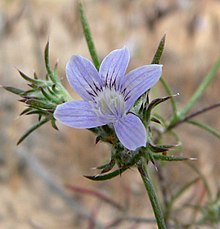
Salvia apiana, the Californian white sage, bee sage, or sacred sage is an evergreen perennial shrub that is native to the southwestern United States and northwestern Mexico, found mainly in the coastal sage scrub habitat of Southern California and Baja California, on the western edges of the Mojave and Sonoran deserts.

Rubus leucodermis, also called whitebark raspberry or blackcap raspberry, is a species of Rubus native to western North America.

Eriogonum fasciculatum is a species of wild buckwheat known by the common names California buckwheat and flat-topped buckwheat. Characterized by small, white and pink flower clusters that give off a cottony effect, this species grows variably from a patchy mat to a wide shrub, with the flowers turning a rusty color after blooming. This plant is of great benefit across its various habitats, providing an important food resource for a diversity of insect and mammal species. It also provides numerous ecosystem services for humans, including erosion control, post-fire mitigation, increases in crop yields when planted in hedgerows, and high habitat restoration value.
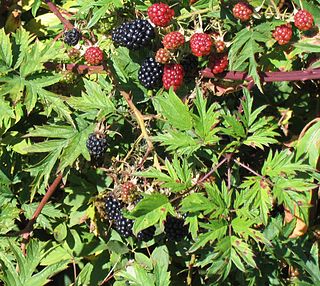
Rubus laciniatus, the cutleaf evergreen blackberry or evergreen blackberry, is a species of Rubus, native to Eurasia. It is an introduced species in Australia and North America. It has become a weed and invasive species in forested habitats in the United States and Canada, particularly in the Northeast and along the Pacific Coast.

Erysimum capitatum is a species of wallflower known commonly as the sanddune wallflower, western wallflower, or prairie rocket.

Arctostaphylos tomentosa is a species of manzanita known by the common name woollyleaf manzanita or woolley manzanita. This shrub is endemic to California.
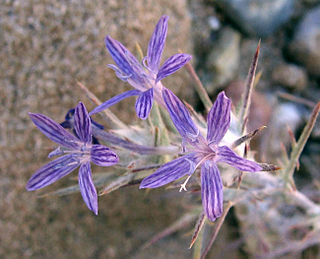
Eriastrum densifolium is a species of flowering plant in the phlox family known by the common name giant woollystar. This wildflower is native to California and Baja California where it grows in open areas such as sand dunes and dry washes. It grows on an erect stem with slightly hairy to densely woolly foliage, often giving the plant a dark gray-green color. The leaves are narrow and spike-shaped with pointed lobes. The top of each stem is occupied by a bunched inflorescence full of woolly leaflike bracts and funnel-shaped, flat-faced flowers. The flowers are each 1 to 3 centimeters long with a face up to three or four centimeters wide. The lobes are white to bright, striking blue, sometimes with longitudinal pinstripes. The stamens protrude from the throat.
Eriastrum luteum is a species of flowering plant in the phlox family known by the common names yellow woollystar and yellow-flowered eriastrum. This wildflower is endemic to California where it is known only from Monterey and San Luis Obispo Counties. This is a small annual rarely reaching the maximum 25 centimeters in height. It has occasional thin, threadlike leaves which are covered in a coat of woolly hairs. The inflorescence is a cluster of leaflike green or reddish bracts strung densely with cobwebby white wool and bearing bright yellow flowers. Each flower has five rounded lobes and long, protruding stamens with large anthers.

Eriastrum pluriflorum is a species of flowering plant in the phlox family known by the common names Tehachapi woollystar and many-flowered eriastrum.

Eriastrum sapphirinum is a species of flowering plant in the phlox family known by the common name sapphire woollystar. This wildflower is endemic to California where it is found in many habitats throughout the state. It is an annual reaching anywhere from 5 to 40 centimeters in height, forming clumps or singular spindly stems. The stem is erect and may be reddish to green, and has the occasional threadlike leaf with sparse hairs to a coat of dense wool. The inflorescences at the tips of the stems are packed with pointed, leaflike green to red bracts and funnel-shaped flowers. The corolla of the flower has five lobes each one half to one centimeter long and pale to bright blue. The throat of the flower is the same color or yellowish to white. At the mouth of the tube there may be dots of yellow and white. The light colored stamens protrude.

Eryngium aristulatum, known by the common names California eryngo and Jepson's button celery, is a species of flowering plant in the family Apiaceae.
Eriastrum abramsii is a species of flowering plant in the phlox family known by the common name Abrams' woollystar. The epithet abramsii commemorates LeRoy Abrams. It is endemic to California, where it is known from the hills of the Coast Ranges in and around the San Francisco Bay Area. It is an annual herb producing a thin, usually woolly stem up to about 15 centimeters tall. The leaves are divided into several narrow, threadlike linear lobes. The inflorescence is a woolly cluster of narrow, leaflike bracts laced with webby fibers. The small flowers have yellow throats and white or blue corolla lobes.
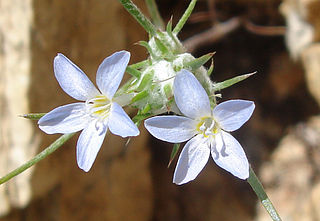
Eriastrum diffusum is a species of flowering plant in the phlox family known by the common name miniature woollystar. It is native to the southwestern United States from California to Texas, where it grows in many types of open habitat. This is an annual herb producing a thin, usually woolly stem up to about 20 centimeters long, growing erect or spreading outward. The leaves are divided into 2 to 4 narrow, threadlike linear lobes. The inflorescence is a woolly cluster of narrow, leaflike bracts laced with webby fibers. The small flowers are funnel-shaped, with yellowish throats and white to pale blue corollas.
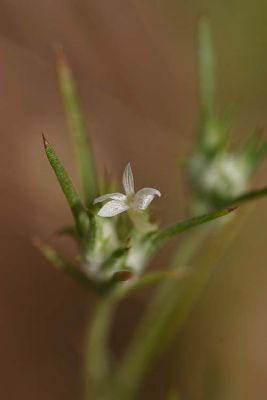
Eriastrum hooveri is a rare species of flowering plant in the phlox family known by the common name Hoover's woollystar. It is endemic to the South Coast Ranges of California from San Benito to Los Angeles Counties, where it grows in grassy open habitat. It is an annual herb producing a wiry, usually woolly stem up to about 15 centimeters tall. The leaves are linear and threadlike, less than three centimeters long, and sometimes divided into two thready lobes. The inflorescence is a woolly cluster of narrow, leaflike bracts laced with webby fibers. The flowers are white and just a few millimeters in length.
Eriastrum virgatum is a species of flowering plant in the phlox family known by the common name wand woollystar. It is endemic to California, where it is known the coastline and coastal mountain ranges of Monterey and San Benito Counties. It grows in chaparral and coastal and inland scrub habitat. It is an annual herb producing a thin, usually woolly stem up to about 40 centimeters tall. The leaves are narrow and thick, up to 5 centimeters long, and sometimes divided into two narrow lobes. The inflorescence is a woolly cluster of narrow, leaflike bracts laced with webby fibers. The flowers have yellow throats and bright blue corollas with lobes up to a centimeter long.
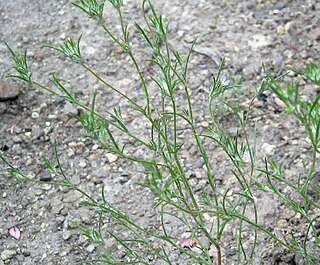
Eriastrum wilcoxii is a species of flowering plant in the phlox family known by the common name Wilcox's woollystar. It is native to the western United States, where it grows in various types of desert and plateau habitat. It is an annual herb producing a thin, branching, usually woolly stem up to about 30 centimeters tall. The leaves are narrow and thready, up to 3 centimeters long, and sometimes divided into two or more lobes. The inflorescence is a woolly cluster of narrow, leaflike bracts laced with webby fibers. The small flowers have yellow throats and blue corollas with lobes up to half a centimeter long.

Corethrogyne filaginifolia is a species of flowering plant in the daisy family known by the common names common sandaster and California aster.

Ribes inerme is a species of currant known by the common names whitestem gooseberry and white stemmed gooseberry. It is native to western North America from British Columbia to California and westward to the Rocky Mountains. It grows in mountain forests, woodlands, and meadows.

Rubus ulmifolius is a species of wild blackberry known by the English common name elmleaf blackberry or thornless blackberry and the Spanish common name zarzamora. It is native to Europe and North Africa, and has also become naturalized in parts of the United States, Australia, and southern South America.
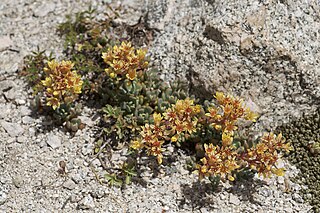
Sedum obtusatum is a species of flowering plant in the family Crassulaceae known by the common name Sierra stonecrop. It is native to the Sierra Nevada and adjacent high mountain ranges of California, its distribution extending north into Oregon and east into Nevada. It grows in rocky mountain habitat.
